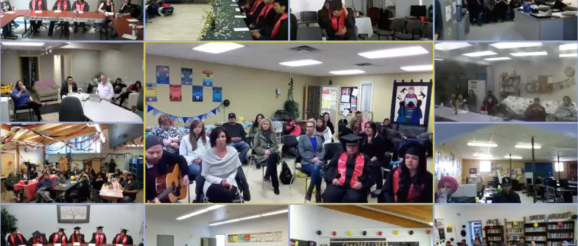Rural innovation: using technology to keep schools in communities | NB Media Co-op

Many rural New Brunswick communities are searching for ways to avoid school closures and long bus rides for students to attend schools in larger centres. As fuel prices rise and the cost of bus transportation becomes unsustainable, is the only political solution to abandon rural communities, so the youth can attend large centralized institutional collector schools? It seems to be the only solution imposed by successive New Brunswick governments. Susan Machum, Dean of Social Sciences at St. Thomas University describes this as “rural bullying.”
Broadband telecommunication infrastructure is making Internet high schools possible and successful in many parts of the country, including New Brunswick where online courses are available for students requiring specific courses. Elementary, secondary and post-secondary courses are available in local classrooms for students wanting to remain close to family, friends and the rural community they know best.
On May 22, in northern Ontario, 37 students met in their local classrooms with their families, community leaders, teachers, fellow students and friends to celebrate their successful completion of their high school programs. Why was this gathering so special? The students and their teachers were sitting in high school classrooms located in 13 remote First Nations and meeting by videoconference with celebration participants in other locations across Canada.
Since 2000, the Keewaytinook Internet High School (KiHS)
has been delivering Ontario-accredited secondary school courses for students, teachers
and classroom assistants who live and work in small remote First Nations
scattered across the far northern region in Ontario. Remote means that the only
means of travel to these communities is by small planes. Winter roads across
frozen lakes provide a small window when fuel, construction materials and other
goods are transported into these communities. Flights are expensive, as are
most goods and supplies.
Everyone watched the one-hour graduation ceremony online. The archive of the gathering allows viewers to watch the entire celebration or scroll through the highlights. Special moments included keynote speaker and award-winning singer Shy-Anne Hovorka’s song for the graduating class (her presentation and song can be found at 21:10 in the video archive); the congratulatory greetings by political leaders from all over the province; and the award presentation in memory of a young Indigenous student who died while attending high school in a far-away urban setting.
“Using the Kuhkenah
Network (KNET) and their communication technologies to connect the
First Nations across Ontario creates new opportunities for community members to
remain in their communities along with new local career opportunities and
services,” stated Lyle Johnson, Technology Lead, Keewaytinook Okimakanak Education.
Nishnawbe
Aski (the people) have always inhabited this part of Canada. They
speak different dialects of Ojibway, Oji-Cree and Cree. Their communities are located
along major river systems flowing into Lake Winnipeg and into the Hudson Bay.
The people are surviving and innovating under very challenging and harsh
conditions. Their love for the land and all their relations is very strong.
“Today’s KiHS graduation ceremony, with 36 graduates, was
the largest event so far in our short 20-year history. Our school continues to grow, and this growth
wouldn’t have been possible without the support from our First Nation partners,
the students, the infrastructure, or the staff at KiHS. The success illustrates what is possible with
a truly locally-driven effort,” explained Angela Batsford-Mermans, KiHS acting principal.
The young people gathered together on May 22 were a cadre of
future parents and leaders effectively using communication technologies to
obtain the skills and experiences required to participate in today’s digital society.
Instead of leaving their communities to attend high school in far-away urban
settings, these young people chose to remain in their communities to work,
raise their families, and contribute to their local economies. They choose to
stay close to the people and the land they love and wish to protect and
sustain.
Every graduate has their own story to tell. Their
experiences are already making history in Canada. They are leaders and teachers
as they decide their next steps on their personal journey. Some will continue
to take post-secondary programs while remaining in their communities with their
families. Others will choose to attend a post-secondary institution in an urban
setting. But they have choices and they have already demonstrated their ability
to be successful.
The RAVEN research project at the
University of New Brunswick is currently studying the broadband infrastructure
in New Brunswick. The study will produce a report describing the limits and opportunities
of telecommunication services across the province to support rural communities,
including identifying the gaps and producing recommendations to address local
needs. In future, moving to a green economy will mean that rural community
members will have a choice where and how they can access education and health
services. These choices will be essential to move beyond a fossil fuel economy.
The young graduates, their families and their community
leaders in Northern Ontario have much to be proud of as they develop their
local remote and rural communities. Other communities and political leaders
have much to learn and gain from their innovation and leadership.
Brian Beaton is a RAVEN project researcher and a NB Media Co-op volunteer maintaining the events calendar. He moved to New Brunswick from Northern Ontario where he worked with the Keewaytinook Okimakanak team supporting the development of KIHS and KNET.
